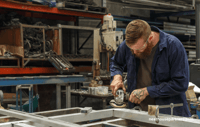Hand tool safety - Annual science review Reflections 2023
Hand tool safety - Annual science review Reflections 2023
James Rowland
Commercial Director James leads Account Management, Sales and Marketing at Neathouse Partners.Date
28 April 2023Updated
20 March 2024
Table of contents
Related articles
Tags
The Health and Safety Executive (HSE) researches various topics related to occupational health and safety, and its Annual Science Review Reflections for 2023 includes two case studies on the use of handheld tools.
It is widely recognized that using handheld power tools can cause hearing damage and result in heavy vibrations that may lead to hand-arm vibration syndrome (HAVS) and the studies examine whether battery-powered tools could be a safer option for workers in terms of the noise and vibrations they produce.
The research aims to identify ways to reduce the risks associated with using power tools and to promote safer working conditions for employees. Here, we've summarised the key findings from both studies so that employers looking to reduce the risks associated with using handheld power tools can ensure they are following the latest guidelines concerning the health & safety of their workers.
Case Study 1: Supporting enforcement to protect the health of workers using hand tools
The problem
Hand-held power tools such as saws and drills can emit noise and vibration, which can pose health risks to workers if not properly controlled. Exposure to high levels of noise can cause hearing damage, while excessive vibration can lead to hand-arm vibration syndrome (HAVS).
What is being done
There is a growing trend towards using battery-powered hand tools in industries such as construction, motor vehicle repair, and grounds maintenance. Some power tool manufacturers claim that battery-powered tools emit considerably less noise and vibration than traditional ones so HSE scientists researched to test the accuracy of this claim by comparing the noise and vibration emissions of battery-powered hand-held tools with those of traditional power tools.
The Study & its findings
The study involved conducting 'in-use' tests on a range of tools that included chain saws, cut-off saws, combi-drills, reciprocating saws, impact drivers/wrenches, and angle grinders. The findings revealed that the noise and vibration levels emitted by battery-powered tools can vary in comparison to their traditionally powered counterparts including being both higher or lower. As a result, to avoid using tools with excessive noise or vibration emissions, employers should first look for tools that can complete the job efficiently and then consider the emission data.
This research was able to ensure more accurate information is provided to help employers choose the safest and most effective tools for their workers. They are advised to follow HSE recommendations provided in the Handarm Vibration L140 (2019)101 and Controlling Noise at Work L108 (2008)102 guidelines to safeguard employees.
- Read more about this study & its results
Case study 2: Protecting angle grinder users from ill health caused by noise and vibration
The problem
Hand-held angle grinders are extensively used in various industry sectors, including steel frame fabrication, where a significant number of Reporting of Injuries, Diseases and Dangerous Occurrences Regulations (RIDDOR) reports on hand-arm vibration syndrome (HAVS) have been filed.
This condition is a painful and debilitating disease that affects the hands, blood vessels, nerves, and joints, and the high levels of vibration produced by these tools increase the risk of ill health for operators. Angle grinders also generate high levels of noise and dust, making them a significant contributor to occupational noise exposure, with enough dust output to cause respiratory illnesses.
The study
An HSE specialist investigated alternative processes and methods to reduce the use of angle grinders, which can emit high levels of vibration, noise, and dust, potentially causing hand-arm vibration syndrome (HAVS) and respiratory illnesses.
The study involved measuring vibration, noise, and dust emissions from a selection of angle grinders and alternative hand-held power tools designed for specific tasks. The results showed that using alternative wheels could significantly reduce emissions, while alternative tools could complete tasks more quickly, reducing the operator's exposure. Overall, reducing or eliminating the use of angle grinders is the most effective way of controlling emissions.
Outcome
New guidance will be introduced to promote alternative tools to angle grinders and abrasive wheels to HSE inspectors and the wider industry. This effort will also enable HSE inspectors to use the guidance as evidence of reasonably practicable controls during enforcement.
Read more about this study & its results
What Can Employers Do With The Information From HSE?
Employers can use the HSE science review findings to improve the health and safety of their workplace by keeping up to date with the latest research and recommendations. For example, the review highlights new research on the dangers of hand-held power tools, so employers can take steps to reduce the risk of harm to their employees by providing training, investing in safer equipment, and implementing effective controls.
Employers can also use the findings to identify areas where their workplace may be falling short of health and safety standards and take action to address any issues. Additionally, employers can work closely with their employees to ensure that they are aware of the risks associated with their work and are taking the necessary precautions to stay safe
- Further Reading: The importance of using manufacturers instructions for business.
Summary
The Health and Safety Executive (HSE) is dedicated to ensuring safe and healthy working conditions for employees in the UK. To achieve this goal, the HSE researches various topics related to occupational health and safety. The research findings are published in reports, reviews, and other publications, which can be accessed through the HSE website to help employers to ensure that they are providing safe and healthy working conditions.
Two case studies discussed in this article highlight the work conducted by the HSE to mitigate risks associated with noise, vibration, and dust exposure caused by tools such as chain saws, cut-off saws, combi-drills, reciprocating saws, impact drivers/wrenches, and angle grinders.
Exposure to high levels of noise can cause hearing damage, while excessive vibration can lead to hand-arm vibration syndrome (HAVS) but thanks to the studies above, it means the HSE can offer advice to inspectors on when battery-powered tools will or won't make a difference to HAMS risk.
Next Steps
Neathouse Partners can help you ensure that your business is providing safe and healthy working conditions for its employees. We can work with you on health and safety audits to assess your existing levels of compliance, review any relevant documentation, such as risk assessments and method statements, and offer guidance on suitable control measures for reducing noise, vibration, and dust exposure caused by tools.
If you would like support with managing and understanding your employer's responsibilities regarding managing an ageing workforce please call 01244 893776 to talk to our friendly team.
Related blog posts

Understanding Safety Signage Regulations as a UK Employer

Health & Safety Updates – UK Regulatory Outlook January/February 2024
Have questions?
Get in touch today
Contact us, and our team will get back to you within 24 hours. We value your questions and are committed to getting them answered quickly.


Hello! I am Nicky
Just fill in the form below with your details, and I will arrange for a member of our team to give you a call.
By clicking, you agree to our Privacy Policy








